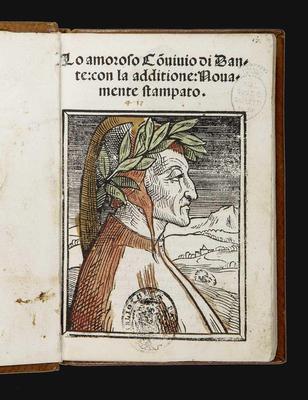Dante Alighieri
Lo amoroso Conuiuio di Dante: con la additione: Nouamente stampato.
Venice, Giovanni Antonio da Sabbio and brothers for Niccolò and Domenico dal Gesù, October 1521.8° (154x100 mm). Collation: a8, a-t8. [8], 151, [1] leaves. Roman and gothic type. On the verso of the title-page woodcut printer's device. Large woodcut portrait of Dante as laureate poet on the title-page, with contemporary colouring. Late nineteenth-century light brown diced morocco, covers framed within border of blind fillets, decorated in gilt with small floral tools. Spine with four raised bands, title and imprint lettered in gilt. A very good copy. On the verso of the front flyleaf the note ‘Rarissimo ed esempl. di stupenda conservazione'. The price notice ‘4-17' inked by an early hand on the title-page.
Provenance: Gustavo Camillo Galletti (1805-1868; stamp on the title-page); Baron Horace de Landau (1824-1903; ex-libris on the front pastedown; Catalogue des livres manuscrits et imprimés composant la bibliothèque de M. Horace de Landau. Première partie, Florence 1885, pp. 162-163); Landau-Finaly collection; Bibliotheca Pagni (stamps on the title-page and at the end); Livio Ambrogio collection.
The rare first sixteenth-century edition of the Convivio, which from a textual point of view follows the first 1490 Florence edition with a few emendations. The Venetian edition is famous for bearing on the title-page the first portrait of Dante ever printed, in the copy presented here – which once belonged to Baron Horace de Landau – in contemporary colouring.
This large woodcut shows Dante's characteristic prominent chin and aquiline nose and severe gaze, all traditional aspects of his appearance. It also shows him wearing the usual cap and laurel wreath. In the background is a level landscape, traversed by a river, with houses in the far distance and behind them a hill. The source of this woodcut profile portrait and its designer are not known, but it is generally argued that the model might have been, with some variations and adaptations, the illuminations found in eithermsPalatino 320 of the Biblioteca Nazionale in Florence orms1040 of the Biblioteca Riccardiana.
Even though no verified iconographic representation of Dante exists, it is possible to divide the images we do have into two standard depictions: one, more youthful, serene and of clear countenance, as seen in Giotto's portrait in the Florentine Bargello museum, discovered in 1840 by Seymour Kirkup, the English painter and a great admirer of Dante; the other, more mature, with heavily pronounced features and a tormented and gloomy look. The late fifteenth- and early sixteenth-century tradition, in painting as well as in printed books, mainly follows this second model, in accordance with the famous physiognomical description of Dante's appearance sketched by Giovanni Boccaccio in his Trattatello in laude di Dante. This model was also adopted by the anonymous and skilled artist who designed the beautiful portrait for the Venetian Amoroso Convivio of 1521: as F. J. Mather states, the best portrait of Dante executed in the sixteenth century.


